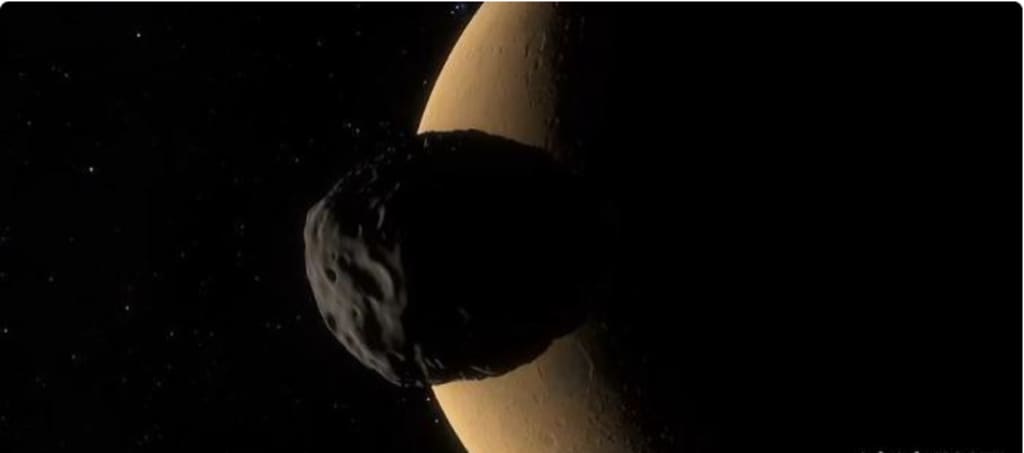Phobos is in the sights of scientists, future human migration plans may also choose Phobos
Important Objects Detected and Studied by Scientists

Mars has been an important celestial body for scientists to explore and study. Was there ever liquid water on Mars? Why did its main magnetic field disappear? Where did the original atmosphere of Mars go? On February 18, the U.S. Mars Rover Tough entered the Martian atmosphere, entering, descending, and landing in seven minutes. A successful landing in Yezero Crater, north of the Martian equator, will lead to an exploration mission. But sometimes, maybe we should take our eyes off Mars and focus on the kids in the Martian neighborhood. There could be big discoveries to be made. Hello everyone. This is Tao's notes. Today, let's talk about the nearby children mentioned here, none other than Mars' moon Phobos.
Phobos is potato-shaped and can circle Mars three times a day. It is also the larger of Mars's two moons and the one closer to Mars. It is only 6,000 kilometers from the surface of Mars. In the latest research on Phobos, scientists have found that charged atoms and molecules that flow out of the Martian atmosphere go to Phobos. This means that the soil of Phobos contains a wealth of key information about the evolution of the Martian atmosphere. The study, published in a recent scientific journal, suggests that perhaps by studying Phobos, we can learn the secrets of Mars billions of years ago. Although Mars is much smaller than Earth, it is interesting to note that Mars has two natural moons, Phobos and Deimos. Of course, both of Mars' moons are so small and inconspicuous in the solar system's array of moons that their existence is often forgotten.
Of the two Mars moons orbiting the planet, the larger one is Phobos. He looks like a space potato. The orbital period is about 8 hours per week and the distance to Mars is less than 9400 km. The distance between Phobos and Mars is much closer than the distance between Earth and the Moon. The formation of Phobos has been controversial for many years. You believe that Phobos may have once been part of Mars, just like the hypothesis of the origin of the Moon. Mars collided with an object, and then some debris went into space, was attracted by Mars' gravity, and became Phobos.
In addition, there is another view that Phobos, which was originally an asteroid, was attracted to Mars as it passed by, thus becoming one of Mars' moons. From the current trajectory of Phobos, this theory is still more reliable. Now Phobos is getting closer and closer to Mars, and it won't be long before he has a big collision with Mars. When Phobos disappears, its debris will likely form a ring around Mars, making Mars the planet with the beautiful halo in our solar system. Many researchers are also more optimistic about Phobos when it intersects with it. There are even ideas that groundwater and various resources needed for humans may exist on Phobos, which means that Phobos will also be part of the future human migration to Mars.
The answer to finding the habitability of early Mars may lie in Phobos. Phobos is tidally locked to Mars, just like the Moon. Only one side always faces Mars, leading to the front of Phobos. It has been under attack from Mars since its birth, just as the Earth's early codes existed on the Moon. Phobos also carried the early code of Mars for at least billions of years. Atoms and molecules in a planet's atmosphere sometimes escape as ions and accelerate into space. When planets have moons orbiting them, those escaped atoms and molecules may be implanted on the surface of the moons and remain on their surfaces.
Scientists speculate that Mars once had a powerful atmosphere, but because it does not have a primary magnetic field like Earth's, the Martian atmosphere is exposed to the solar wind, and its atmospheric components are ionized by the Sun's ultraviolet light into charged molecules or atoms. The Sun's electric field accelerates the escape of these charged particles in the opposite direction of the Sun. Li Lei, a researcher at the National Air Force Science Center of the Chinese Academy of Sciences, said that during the escape, these instances probably hit Phobos and were absorbed by its weathering layer, thus being preserved. So how can scientists be sure that the particles near Phobos' orbit come from the Martian atmosphere and not from other pathways? Because there are only two major sources of particles in space near Mars, the Martian atmosphere and the solar wind. The two have different compositions and energies and are easily distinguishable. Of course, the existence of particles from other sources in interplanetary space is not excluded. But the number of these particles is very rare, almost negligible.
In addition, charged particles in the Martian atmosphere are accelerated by the solar wind and then enter the probe to produce an electrical signal. By measuring the electrical signals, parameters such as the speed, direction, and composition of the particles can be inferred. To truly understand the specifics of Phobos, it is not enough to send a probe to take pictures. NASA proposes to collect soil from Phobos and analyze it in a laboratory on Earth. Scientists can learn basic information about the evolution of the Martian atmosphere. Scientists know that Mars once had an atmosphere thick enough to support liquid water on its surface, but now the red planet's atmosphere is less than 1% as dense as Earth's. Now Japan has plans to launch a probe to Phobos in 2024, with plans to return samples to Earth for in-depth study.
Of course, exploring Phobos is not as simple as exploring the moon. If Japan does it, it will be one of the best proofs of Japan's space prowess. That said, researchers still have high hopes for Phobos. As I mentioned earlier, when humans migrate to Mars in the future, Phobos may have the same chance as the Moon to be transformed into a human space base. Currently, some scientists are planning that humans need to conquer Phobos before they can conquer Mars.
As early as the last century, some researchers have suggested that for human civilization to continue, it needs to take civilization to many planets. In this way, even if the Earth is wiped out in the future, humans can continue their civilization on other planets and avoid the extinction of their race. Looking at the solar system, besides Earth, the most suitable planet for human habitation today is Mars. The future Mars base will also become a huge human community. However, it would take too much time and cost to transport all the materials from Earth to Mars. Therefore, the study concluded that Phobos would first need to be modified to make it a backup planet for the Mars base.
Like the Moon, Phobos is a complete vacuum, which means that it would be easier for humans to modify Phobos than to modify Mars. Just build a large base, then simulate the Earth's environment in the base and cultivate plant species that humans can eat. After that, food supplies for the Mars base could be delivered from Phobos without having to travel great distances through Earth. Also, because of the similarity between Phobos and Mars, some future Mars-based experiments could be done on Phobos first. It is safe to say that researchers are currently looking forward to Phobos, and only the Japanese sample will return to Earth in 2024.
Do you think humans can do it? This concludes this article. What do you think of this article? Please discuss it in the comments below. If you like this article of mine, you can pay attention to it, and you will be notified of the content updates first.






Comments
There are no comments for this story
Be the first to respond and start the conversation.